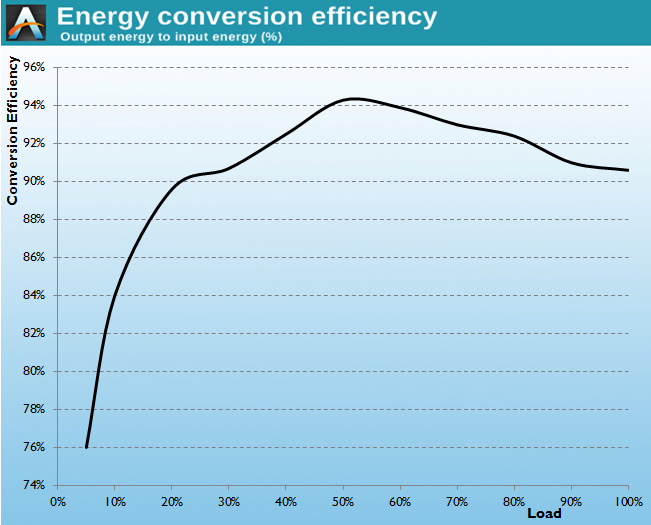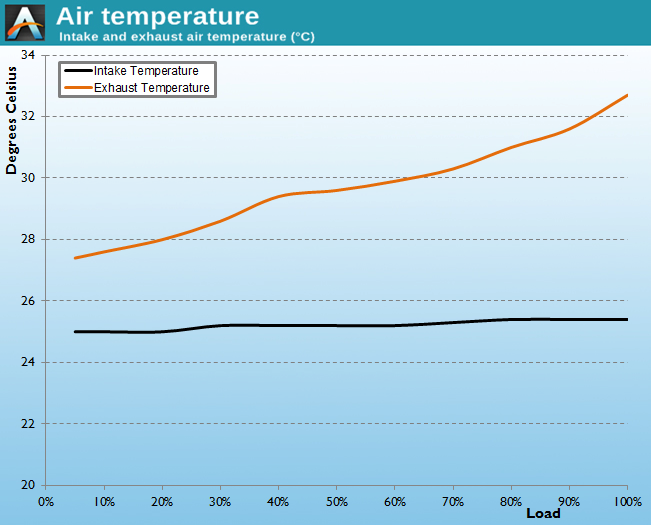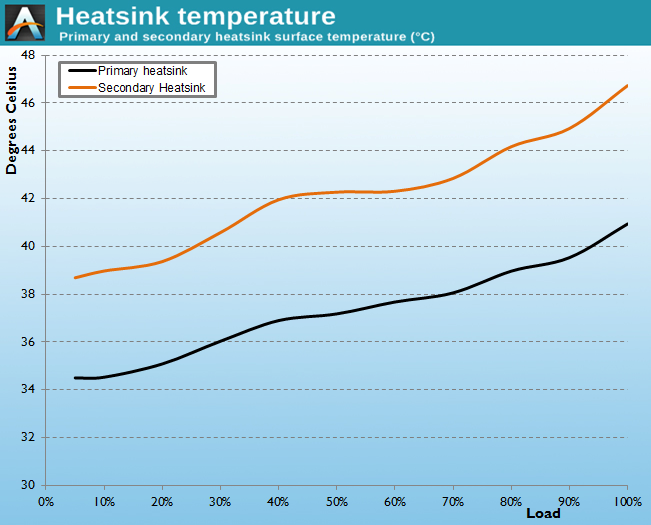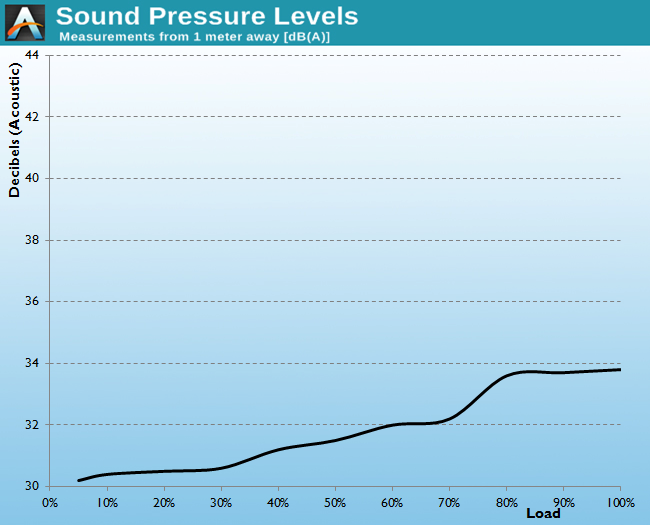Seasonic S12G 650W Power Supply Review
by E. Fylladitakis on February 28, 2014 2:20 PM EST- Posted in
- Cases/Cooling/PSUs
- Seasonic
- 80 Plus Gold
Test Equipment and Methodology
For the testing of PSUs, we are using high precision electronic loads with a maximum power draw of 2700W, a Rigol DS5042M 40MHz oscilloscope, an Extech 380803 power analyzer, two high precision UNI-T UT-325 digital thermometers, an Extech HD600 SPL meter, a self-designed hotbox, and various other bits and parts. For a thorough explanation of our testing methodology and more details on our equipment, please refer to our How We Test PSUs - 2014 Pipeline post.
Cold Test Results
At room temperature, the Seasonic S12G 650W unit easily honors its 80 Plus Gold certification, reaching up to 94.4% efficiency at 50% load. Inside the normal operating range of the power supply, which is between 20% and 100% load, the efficiency remains above 90% at all times. In fact, if the S12G was just a little more efficient while heavily stressed, it could hit 80 Plus Platinum status.
As expected, the efficiency drops sharply when the load is below 20% (130W in this case), dropping down to 76% with a 32W load, but it goes up to 84% when the load is increased to 65W. These are considered "out of range" conditions and do not affect the 80 Plus certification of the unit, but considering many modern PCs will idle at 40-60W, it's still worthwhile to look at performance at these loads. Of course, at 32W load the difference between 75% and 85% efficiency only amounts to around 5W at the outlet.
Both the air and the heatsink temperatures might appear a little high for a unit of this capacity and efficiency operating at room temperature, but that is because the fan of the Seasonic S12G 650W PSU is being "lazy" -- or "quiet" if you prefer. The fan is thermally controlled and it looks like Seasonic decided it didn't need to spin faster under such testing conditions. During our SPL testing, the fan reaches audible levels only after the unit hits ~80% of its rated output.














77 Comments
View All Comments
tynopik - Saturday, March 1, 2014 - link
> if I short the rectifier bridgeI mean on the component side. Cables can and do short and it should NOT cause permanent harm to the PSU (or to other components on other cables). If it does, the PSU is poorly designed.
> if the distibution grid around your area shifts like "a DJ is rotating the knob", which is not really possible (infinite bus theory)
The request is based off an incident that actually did happen to me. The power dipped 3 times in quick succession and the power supply blew and took out everything connected to it. Granted this was before I knew better and it was a crappy unit running right at its limit, but PSUs do have to deal with power 'variances' in the real world.
E.Fyll - Sunday, March 2, 2014 - link
Shorting a component = OCP protection. I always perform such tests before proceeding to testing the unit. I don't it that to fail catastrophically with $12.000 connected to it...I do understand that this might have had happened to you. It most likely was due to the catastrophic failure of a distribution grid's component. Still, that is not a fault of the PSU, it is an issue with your energy supplier. Your energy supplier is under contract to provide you with electricity of specific quality. If you have such severe problems with your distribution grid, you do not need a better PSU, you need a lawsuit.
HangFire - Monday, March 3, 2014 - link
I'm glad to hear you test OCP. Will you be testing it on all 3 voltage rails?As for voltage variances, they are not typically due to catastrophic failures. Quite mundane failures such as tree and animal shorts happen often, and there is a high voltage protocol to burn them off and resume normal power that sounds just like the poster's experience.
Power in proximity to manufacturing areas can show the effects of large electric motor startup and shutdown. Grids switching in and out contingent power sources can introduce phase issues, and so on.
Blowing all of these off as unusual or the result of large failure is not realistic.
HangFire - Monday, March 3, 2014 - link
Here is a good overview: http://apcdistributors.com/white-papers/Power/WP-1...E.Fyll - Tuesday, March 4, 2014 - link
It is entirely realistic, simply because a) they are unusual and b) are not a problem of the PSU itself but a problem caused by your grid.Large motors and appliances that could cause a voltage drop are not being fed by the consumer distribution grid. Anything above a medium industry is being powered by polyphase distribution. So you being in the same grid as a massive motor, no, it is not going to happen. You are connected on a distribution bus, which is nearly infinite (hence the term "infinite bus") and will no bulge even when huge generators start. If there is an appliance capable of causing a voltage surge or drop connected into the residential grid near you, that is a problem.
Trees and animals are a) not mundane failures and b) definitely not just being "burned off and resume". If an animal shorts two distribution phases and no safety kicks in, the current inbalance will easily destroy a large transformer in milliseconds.
The faults that are being described in APC's white paper certainly are correct and possible. Well, to an extend; after all, it is a paper meant to advertise how good having a UPS is, not really a scientific document. This does not mean that they are frequent, nor that they can be replicated by "rotating the knob". See these ups and downs the waveform does in their examples? Your household grid is doing 50 or 60 of them, depending on where you live, *per second*. The faults rarely have a length of more than a few milliseconds. Rotating a knob 100.000 times per second is definitely not possible, specialized equipment is required to replicate any such test.
HangFire - Friday, March 7, 2014 - link
I'm not the one suggesting the knob methodology.I would have agreed with you when I lived in the suburbs. Since moving to a rural area, I can assure you that brownouts, tree related outages and crossed power lines are quite common here. Besides trees the big threat here is drivers hitting utility poles. Very common this time of year, the combination of ice and hill country is quite hazardous, and many of the poles here carry two sets of voltages. In one event just a few years ago, every lightbulb in my house lit up very bright. I lost 5 lightbulbs and 2 small appliances.
HangFire - Friday, March 7, 2014 - link
I guess MY point is that Active PFC power supplies are supposed to take a range of voltages; but I don't see anyone testing that. I test it every few months, when I get out the 100 foot extension cord and use a PC with 5.1 speaker system for party tunes. (My guests are not picky I guess). I use quality hardware, usually a Seasonic so I'm OK but I wonder what the limits are for the cheaper stuff.tynopik - Saturday, March 1, 2014 - link
I can see where 'component side' could be confusing. I mean 'external to the power supply'. No of course I don't expect you to go digging inside a unit and shorting things out.tynopik - Saturday, March 1, 2014 - link
> the performance of a PSU in situations that will almost never arise should not influence a buying decision.it depends on what you mean by 'almost never' and what the consequences of failure in those cases are.
New Orleans is 'almost never' hit by a hurricane. Does that mean they shouldn't worry it?
Saving a few dollars a year by being more efficient in the usual case is great, but if it blows your system during a random power blip, was it worth it?
CeceliaAFolger - Sunday, March 2, 2014 - link
this is a goor site to earn $145 per Month ..........